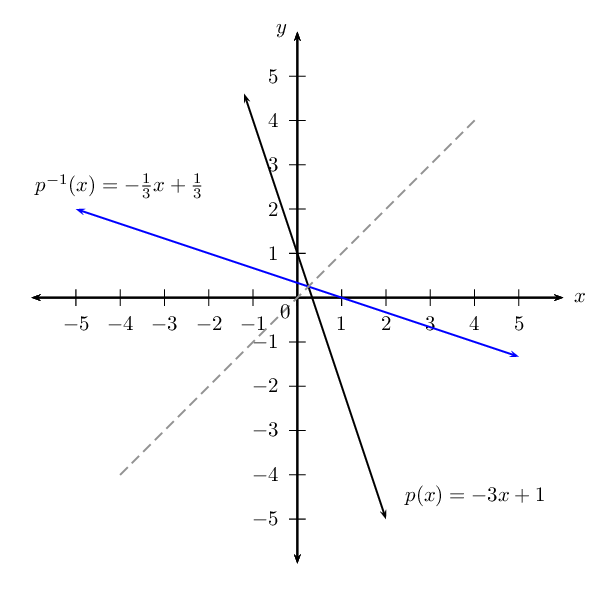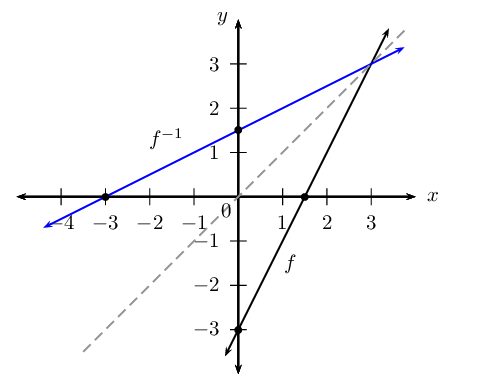Given \(f\left(x\right)=5x + 4\), find \({f}^{-1}\left(x\right)\).
2.4 Linear functions
|
Previous
2.3 Inverse functions
|
Next
2.5 Quadratic functions
|
2.4 Linear functions (EMCF9)
Inverse of the function y=ax+q (EMCFB)
Worked example 4: Inverse of the function y=ax+q
Determine the inverse function of p(x)=−3x+1 and sketch the graphs of p(x) and p−1(x) on the same system of axes.
Determine the inverse of the given function
- Interchange x and y in the equation.
- Make y the subject of the new equation.
- Express the new equation in function notation.
Therefore, p−1(x)=−x3+13.
Sketch the graphs of the same system of axes

The graph of p−1(x) is the reflection of p(x) about the line y=x. This means that every point on the graph of p(x) has a mirror image on the graph of p−1(x).
To determine the inverse function of y=ax+q:
(1)Interchange x and y:x=ay+q(2)Make y the subject of the equation:x−q=ayxa−qa=aya∴y=1ax−qaTherefore the inverse of y=ax+q is y=1ax−qa. If a linear function is invertible, then its inverse will also be linear.
Worked example 5: Inverses - domain, range and intercepts
Determine and sketch the inverse of the function f(x)=2x−3. State the domain, range and intercepts.
Determine the inverse of the given function
- Interchange x and y in the equation.
- Make y the subject of the new equation.
- Express the new equation in function notation.
Therefore, f−1(x)=x2+32.
Sketch the graphs on the same system of axes

The graph of f−1(x) is the reflection of f(x) about the line y=x.
Determine domain, range and intercepts
Domain of f:{x:x∈R}Range of f:{y:y∈R}Intercepts of f:(0;−3) and (32;0)Domain of f−1:{x:x∈R}Range of f−1:{y:y∈R}Intercepts of f−1:(0;32) and (−3;0)Notice that the intercepts of f and f−1 are mirror images of each other. In other words, the x- and y-values have “swapped” positions. This is true of every point on the two graphs.
Domain and range
For a function of the form y=ax+q, the domain is \left\{x:x\in ℝ\right\} and the range is \left\{y:y\in ℝ\right\}. When a function is inverted the domain and range are interchanged. Therefore, the domain and range of the inverse of an invertible, linear function will be \left\{x:x\in ℝ\right\} and \left\{y:y\in ℝ\right\} respectively.
Intercepts
The general form of an invertible, linear function is y=ax+q \enspace (a \ne 0) and its inverse is y=\frac{1}{a}x-\frac{q}{a}.
The y-intercept is obtained by letting x=0:
\begin{align*} y &= \frac{1}{a}(0)-\frac{q}{a} \\ y &= -\frac{q}{a} \end{align*}This gives the point \left(0; -\frac{q}{a}\right).
The x-intercept is obtained by letting y=0:
\begin{align*} 0 &= \frac{1}{a}x -\frac{q}{a} \\ \frac{q}{a} &= \frac{1}{a}x \\ q &= x \end{align*}This gives the point (q; 0).
It is interesting to note that if f\left(x\right)=ax+q \enspace (a \ne 0), then {f}^{-1}\left(x\right)=\frac{1}{a}x-\frac{q}{a} and the y-intercept of f\left(x\right) is the x-intercept of {f}^{-1}\left(x\right) and the x-intercept of f\left(x\right) is the y-intercept of {f}^{-1}\left(x\right).
Inverse of the function \(y = ax + q\)
Consider the relation \(f\left(x\right)=-3x-7\).
Is the relation a function? Explain your answer.
It is a function. Every \(x\)-value relates to only one \(y\)-value, it is a one-to-one relation.
Identify the domain and range.
Determine \(f^{-1}(x)\).
Sketch the graph of the function \(f\left(x\right)=3x-1\) and its inverse on the same system of axes. Indicate the intercepts and the axis of symmetry of the two graphs.
The intercepts are:
\begin{align*} f(x): x = 0, y = -\text{1}\\ y=0, x = \frac{1}{3}\\ f^{-1}(x): x = 0, y = \frac{1}{3}\\ y = 0, x = -\text{1} \end{align*}
\(T\left( \frac{4}{3}; 3 \right)\) is a point on \(f\) and \(R\) is a point on \(f^{-1}\). Determine the coordinates of \(R\) if \(R\) and \(T\) are symmetrical.
Explain why the line \(y = x\) is an axis of symmetry for a function and its inverse.
To reflect a function about the \(y\)-axis, we replace every \(x\) with \(-x\). Similarly, to reflect a function about the \(x\)-axis, we replace every \(y\) with \(-y\). To reflect a function about the line \(y=x\), we replace \(x\) with \(y\) and \(y\) with \(x\), which is how we determine the inverse.

Will the line \(y = -x\) be an axis of symmetry for a function and its inverse?
Given \({f}^{-1}\left(x\right)=-2x+4\), determine \(f\left(x\right)\).
Calculate the intercepts of \(f(x)\) and \(f^{-1}(x)\).
Consider \(f(x)\):
\begin{align*} \text{Let } y & = -\frac{1}{2}x + 2 \\ \text{Let } x=0: \quad y & = -\frac{1}{2}(0) + 2 \\ y & = 2 \\ \therefore y &-\text{intercept is } (0;2) \\ & \\ \text{Let } y=0: \quad 0 & = -\frac{1}{2}x + 2 \\ -2 & = -\frac{1}{2}x \\ x & = 4 \\ \therefore x &-\text{intercept is } (4;0) \end{align*}Consider \(f^{-1}(x)\):
\begin{align*} \text{Let } y & = - 2x+4 \\ \text{Let } x=0: \quad y & = - 2(0) + 4\\ y & = 4 \\ \therefore y &-\text{intercept is } (0;4) \\ & \\ \text{Let } y=0: \quad 0 & = - 2x+4\\ 2x & = 4 \\ x & = 2 \\ \therefore x &-\text{intercept is } (2;0) \end{align*}Therefore the intercepts for \(f(x)\) are \((4;0)\) and \((0;2)\) and the intercepts for \(f^{-1}(x)\) are \((2;0)\) and \((0;4)\).
Determine the coordinates of \(T\), the point of intersection of \(f(x)\) and \(f^{-1}(x)\).
To find the point on intersection, we let \(f(x) = f^{-1}(x)\):
\begin{align*} -\frac{1}{2}x + 2 & = -2x + 4 \\ -\frac{1}{2}x + 2x & = 4 - 2 \\ \frac{3}{2}x & = 2 \\ \therefore x & = \frac{4}{3} \\ \text{And } y & = -2 \left( \frac{4}{3} \right) + 4 \\ & = - \frac{8}{3} + 4 \\ & = \frac{4}{3} \end{align*}This gives the point \(T \left( \frac{4}{3};\frac{4}{3} \right)\).
Sketch the graphs of \(f\) and \(f^{-1}\) on the same system of axes. Indicate the intercepts and point \(T\) on the graph.

Is \(f^{-1}\) an increasing or decreasing function?
Decreasing function. The function values decrease as \(x\) increases.
|
Previous
2.3 Inverse functions
|
Table of Contents |
Next
2.5 Quadratic functions
|
